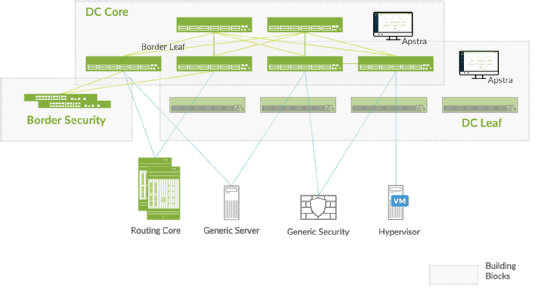
Getty Images/iStockphoto
Juniper updates Apstra intent-based networking for the edge
Juniper has targeted edge data centers with a suite of updates to its intent-based networking platform Apstra. Also, Juniper has new IBN security and professional services.
Juniper Networks has updated its intent-based networking platform Apstra with features that tailor it for the edge data center.
The enhancements include support for collapsed fabric topologies, new Apstra professional services to help with migration, and zero-trust security policies. The improvements will help smaller, more distributed and more IoT-heavy enterprises use intent-based networking (IBN) to design, deploy and operate edge data centers, according to Juniper.
Apstra's intent-based networking software helps companies design networks based on what the finished network is supposed to do, rather than starting from the ground up. The software was acquired when Juniper bought Apstra at the end of 2020.
The update will support collapsed fabric topologies, a network architecture resembling a leaf-and-spine topology with no leaf layer common in smaller deployments. Additionally, Juniper is extending all of Apstra's existing capabilities -- such as closed-loop automation and root-cause identification -- to edge data center use cases.
The update enhances Apstra's policy assurance capabilities. Users can specify group-based security policies, and Apstra will alert them of duplicated or conflicting rules. Also, an increased ability to segment the network will help users implement zero-trust security.
Other improvements include role-based access control for multi-vendor environments and restrictions for multi-tenant networks.
Juniper introduced professional services for migrating a network to Apstra. They include consultation and implementation assistance.

The Apstra update brings IBN to new markets, said Mike Bushong, Juniper's vice president of data center product management.
"How do I extend the goodness of intent-based networking? Step 1, make it relevant in more scenarios; Step 2, make it relevant to more than just networking and start to pull in the security bits; Step 3, make it accessible to a class of customers for whom it was just out of reach before," Bushong said. "Put together, what we're doing is taking a run at the data center market."
Other options are on the market to help design and run an intent-based network, such as Arista's CloudVision or Cisco's portfolio. However, because Apstra is a vendor-agnostic software overlay, the updated platform could appeal to edge data centers that already use other vendors' networking products, further broadening the potential market share, said IDC analyst Brad Casemore.
Appealing to smaller environments at the edge is a smart play for Apstra because automation is more imperative there than in large data centers, Casemore said.
"You don't necessarily want IT staff and personnel to be in those edge environments, because it affects the return on investment you'll get from [the personnel]," he said. "It also will impact the agility of those environments and the flexibility."
The type of network automation Apstra describes is "absolutely essential" for the edge data center, Casemore said.
The Apstra enhancements will be available in the second quarter of 2022.
Madelaine Millar is a news writer covering network technology at TechTarget. She has previously written about science and technology for MIT's Lincoln Laboratory and the Khoury College of Computer Science, as well as covering community news for Boston Globe Media.






